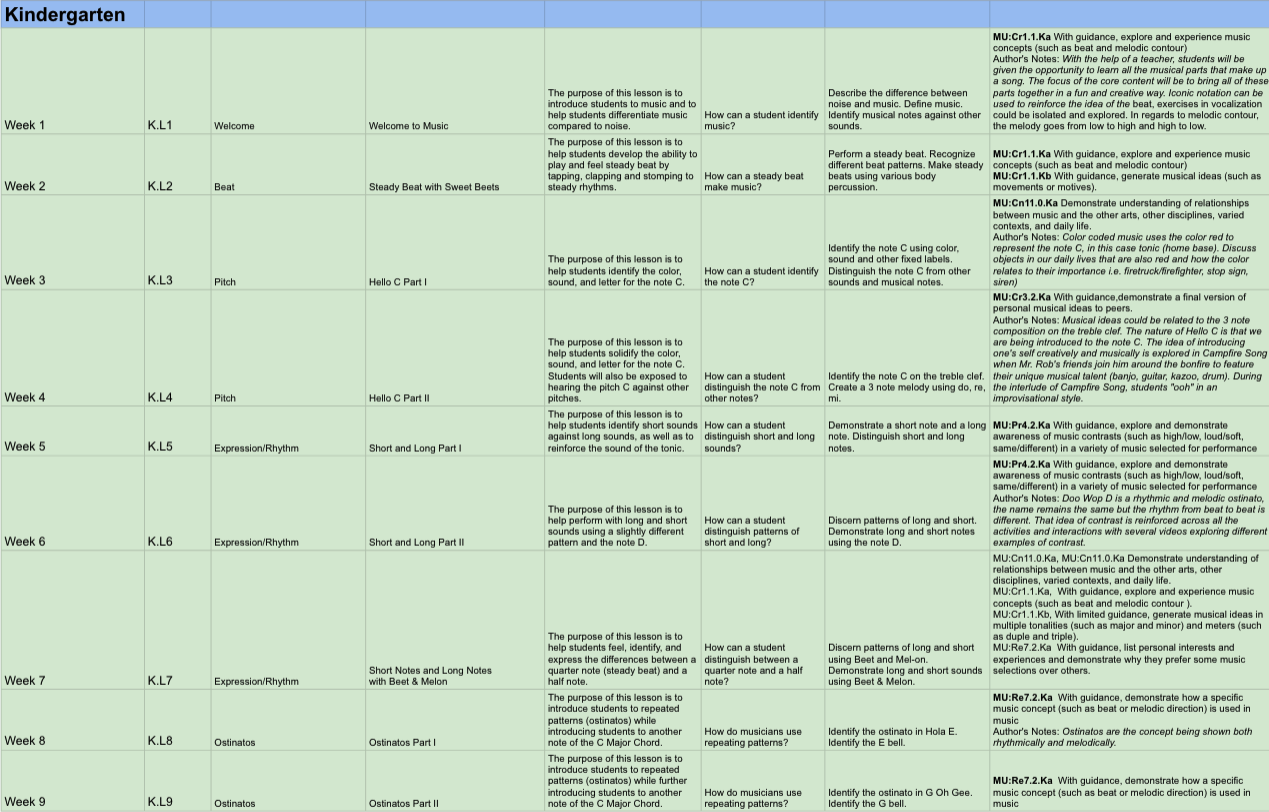Prodigies Academy delivers a robust standards-aligned curriculum for the PreK – Grade 5 music teacher. Each lesson inside Prodigies Academy is aligned to NAfME standards with crosswalks and references to VAPPA, TEKS and to a growing library of state-specific standards.
Pre K – 5 Standards Alignment at Prodigies Academy
Each lesson also includes a Lesson Overview, a Lesson Essential Question, and Concepts / Objectives. And each grade level is already sequenced and paced, but is also fully-customizable.

Prodigies Academy takes pride in its unwavering commitment to delivering top-tier music curriculum aligned with NAfME, Texas TEKS, and California’s VAPPA standards. Our curriculum, rooted in a love for music theory, pitch training and instrumental performance, empowers students with the skills and knowledge to thrive in the world of music and beyond.

Standards-Aligned Approach
Our commitment to excellence is evident in how we consistently align and crosswalk our curriculum to different states with different standards including the Texas TEKS and California’s VAPPA standards, addressing the unique requirements of students from these regions. By adhering to these state-specific standards, we guarantee that learners receive education that is tailored to meet the expectations of their local education authorities while maintaining a high level of quality and effectiveness.
National Core Arts Standards (NCAS)
As advocates for music education on a national scale, Prodigies.com proudly incorporates the National Core Arts Standards (NCAS) into our comprehensive curriculum. The NCAS provides a framework that emphasizes artistic literacy, creativity, and the development of essential artistic skills. By integrating NCAS, our platform not only fosters a deep appreciation for music but also prepares students to excel in the dynamic and ever-changing world of the arts.
Accessibility and Inclusivity
We firmly believe that education should be accessible to all, regardless of geographical location or socioeconomic background. Through our online platform, Prodigies.com extends its reach to students across the nation, breaking barriers to music education. Moreover, by adhering to national and state standards, we ensure that our program caters to a diverse range of learners, creating an inclusive environment that celebrates individuality and fosters a lifelong love for music.
Head Start Standards for Preschool
Prodigies is also aligned with the Head Start Child Development and Early Learning Framework. Our roots are in preschool music and the program is especially effective when it comes to teaching young children life long musical skills.
Click here to see how our curriculum aligns with Head Start Standards.
Raising the Standards for Early Childhood Music Education
Most of the early ed standards for music involve movement, appreciation, exposure and exploration with shakers and sticks.
While all of these standards have strong merit, actually learning a musical instrument, which is arguably the highest form of music appreciation and exposure, hasn’t worked it’s way into the early education mainstream.
Here at Prodigies, we strongly believe that there are three main standards missing from the list above. It is our hope that with our easy-to-use program, schools will be able to introduce higher level musical concepts and standards to their students. Namely:
1. Learning the basics of a melodic instrument (such as low v high notes on piano or bells)
2. Meaningful play with individual musical notes (to develop a child’s long term sense of pitch and music)
3. Rhythmic play through teacher led call-and-response
For the most part, achieving standards like this requires highly specialized teachers, expensive instruments and small group or even one-on-one instruction.
Thanks to technology and a little bit of help from Prodigies, now anyone can get the amazing cognitive benefits of learning to play an instrument! It is our hope to expand on what the average preschool learner is exposed to through our fun, colorful and standards aligned approach.
Meaningful Exposure to Pitch During the Critical Years for Auditory Development
When it comes specifically to preschool children, modern research shows us that developing a strong sense of pitch happens in early childhood.
This is why our program focuses heavily on giving children meaningful play with pitch during the critical years for auditory development.
This kind of play with music is easy to facilitate no matter who you are; you just need the right kind of instrument and a little bit of guidance.
So not only does it play to the strength of the preschooler–who has a rapidly developing ear, but not the best fine-motor skills, it also plays to the strength of a loving parent or teacher, who might not know a ton about music, but can certainly guide children through a color coded and error-proof program.
Our hope is to make the concept of meaningful play with individual notes a staple in preschool classrooms and homes everywhere.
